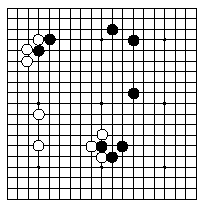
|
Only have a few minutes? Read through this quickly and you are ready to go. If you have more time, however, we recommend you read through the complete tutorial.
|
|
As you put your stones down and see the patterns and situations develop, you will be learning how to play. Two players sit face to face with the Go board, an empty grid, between them. Players choose either black or white pieces, called stones. In an even game, Black plays first. In a handicap game, Black begins with stones already on the board, and White makes the first move. Players take turns, playing one stone at a time, on the intersections on the grid, called points. The object of the game is to coordinate your stones to surround more points than your opponent. All stones on the board will have one or more grid lines, called liberties, extending from them, or will be connected by lines to stones of the same color that have liberties. If all the liberties are blocked, the stone is said to be captured. Captured stones are removed from the board. Once played, stones do not move, unless they are captured. You can't play on a point without liberties, as a stone played there is immediately removed. An exception is when you are capturing stones, as you gain liberties by capturing. As a consequence of these rules, you will discover that some stones are safe, that is, they can never be captured, if they have surrounded two separate points, called eyes. Groups that have or can make two eyes are said to be alive. Stones or groups of stones that can be captured are said to be dead. An exception is the rare situation called dual life, where neither side has two eyes, yet neither side can capture. A consequence of the rule that you gain liberties by capturing, therefore you may play on a point without liberties if you are capturing, is that a shape called ko may develop. The rule of ko is important because it allows the game to continue. In some situations players could immediately capture a stone that has just captured, resulting in an endless stalemate. In these cases, the rule of ko states that you may not immediately capture a stone that has just captured in ko until you have played somewhere else on the board first. The game is over when both sides pass. Players should only pass when no more points can be surrounded. In practice knowing when there are no more points to be surrounded and passing at the correct time is difficult. You may cost yourself points by continuing to play, or lose the opportunity to make points by passing too early. Once both players have passed, count the number of surrounded points. Captures and dead stones count as an additional one point each. The player with more points is the winner. Like to know a little more before you start? Read through the full tutorial. |
|
Problems with our site?
Email:
webmaster@samarkand.net
